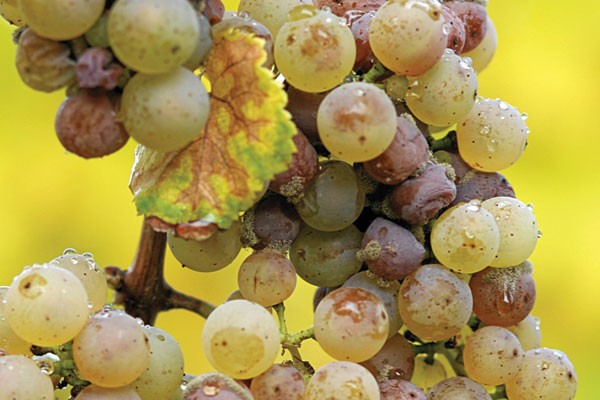If an ugly duckling can grow into a beautiful swan, then perhaps it’s no surprise that the most delicate, delicious dessert wines are made from rotten grapes.
Botrytis cinerea is the dangerous mold that nearly all growers of grapes and other fruits worldwide fear as a destroyer of crops—and incomes. When carefully monitored, however, growths of the same fungus can do wonderful things to grapes—causing shriveling, intensification of the sugars and enhancement of flavor. For these reasons, winemakers call the mold “noble rot.”
The most famous “Botrytized” wines come from southern Bordeaux’s Sauternes region, where Sémillon and Sauvignon Blanc grapes, harvested late in the fall with a dusty gray covering of fungus, are transformed into golden wines that taste deliciously of melons, pineapple and honey. Some, like the Sauternes from Chateau d’Yquem, are among the most prestigious wines in the world, commanding hundreds of dollars per bottle as newly released vintages. The area’s unique warm-but-wet climate is said to be the perfect environment for Botrytis cinerea to thrive.
But in California, a few inspired winemakers have emulated the old traditions of Sauternes. Mondavi, for one, has made a Botrytized white wine called, simply, Botrytis. At Longboard Vineyards, in Healdsburg, founder and winemaker Oded Shakked makes a sweet Sémillon bettered by the fungal fuzz of noble rot. And Dolce, a one-wine brand based in Oakville, also produces a Botrytized white sweet wine.
[page]
Marco Cappelli, who makes Sauternes-style wines for both Swanson Vineyard in Oakville and his own Sierra foothills winery, Miraflores, first tried his hand at utilizing Botrytis-infected grapes in 1987. That fall, while out prospecting for grapes near Napa, Cappelli came upon a vineyard of fruit smoldering under the gray, sooty rot of Botrytis cinerea. Cappelli had spent a harvest season working at Chateau La Tour Blanche, a winery in the heart of the Sauternes region, just two years before, and he recognized the noble rot.
“It was a wonderful growth of Botrytis,” he remembers.
Having watched up-close the making of a Sauternes vintage, Cappelli was inspired to give the process a shot. It turned out well.
“We wound up with four barrels of this wonderful Botrytis wine,” he says.
It got accidentally combined with a non-Botrytized Sémillon barrel, and that vintage was thus blended out of the winery’s record books, but Cappelli would reattempt the process in following years—and with success. His Swanson Crepuscule and Miraflores Botricelli have since become two of his recurring signature dessert wines.
Some years promote a stronger growth of Botrytis cinerea than others, and Cappelli says 2006, 2008 and 2010 were exceptional vintages. The 2008 Botricelli, for one, is dazzling, with smells of zesty fruits and flavors of honey, pineapple, vanilla, caramel and even grilled buttered corn.
But sometimes Botrytis turns foul. Ideally, noble rot is a clean, pure presence of Botrytis cinerea alone, but when other molds and bacteria appear, the effects are ruinous. The grapes turn mushy and useless, and they melt off the vines. Winemakers call such overmoldy conditions “bunch rot.”
[page]
“You’ll know in a second as you walk into a vineyard if you have bunch rot or not,” Cappelli says. “You’ll smell vinegar.”
For any winemaker who has encouraged mold in the vineyard and is banking on a vintage of dessert wine to retail at $300 or $400 a case, such seasons are disasters.
“It’s a gamble, because if you lose the crop, it’s totally useless and it’s a lot of money lost,” says Phil LaRocca, of LaRocca Vineyards near Chico. LaRocca makes an annual Botrytized sweet red Zinfandel.
But noble rot on its own is delicious, according to Cappelli.
“It’s a little unsettling to pop one of those moldy berries in your mouth, but it tastes like honey,” he says.
Long ago in Europe, winemakers made the very same observation before deciding to try fermenting such infected grapes. Over time, utilizing noble rot to produce standout wines became a highly refined practice, and certain methods became standard. In the Sauternes region, the tradition is to use an 80-20 blend of Botrytized Sémillon and Sauvignon Blanc grapes, fermented naturally beginning at a supersweet potential alcohol sugar level of about 35 percent. By the time the yeast is finished fermenting, the wine usually measures about 13 percent alcohol by volume, with about 13 percent residual sugar.
Hungarian winemakers also take advantage of Botrytis cinerea to make a golden white wine called Tokaji. Traditionally made with six grapes unique to the region, Tokaji ranges from dry to sweet and is a protected style, like Champagne and Chianti—and Sauternes.
Winemakers aren’t the only ones using Botrytis cinerea to their advantage. Since 2011, Dogfish Head Craft Brewery of Milton, Del., has been making a beer-wine hybrid using Botrytized Viognier grapes from Washington. The grape-juice-infused ale is called, plainly, Noble Rot. Available locally, it is smooth, creamy, a little spicy and faintly redolent of pineapple—thanks, surely, to the grapes.
Even though they were rotten.











